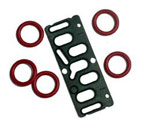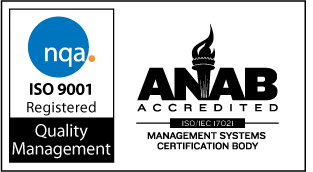
|
7108
S. Alton Way, Unit I |
(303) 758-2728
Home > Problems Solved > Oversize Groove
The Case of the Oversize O-Ring Groove
 What
do you do when you've machined up several thousand housings and find that
the o-ring grooves are oversize because of poor o-ring groove design?
That's what happened to a small manufacturer of portable equipment. He
came to us and asked what the cost would be to make a mold for a special
size. To him, that was cheaper than discarding all the housings. We said,
"OK, but let's look at the dimensions and application first".
What
do you do when you've machined up several thousand housings and find that
the o-ring grooves are oversize because of poor o-ring groove design?
That's what happened to a small manufacturer of portable equipment. He
came to us and asked what the cost would be to make a mold for a special
size. To him, that was cheaper than discarding all the housings. We said,
"OK, but let's look at the dimensions and application first".
It was a static application, always good to know if you plan on playing games with sizes. The original design used a 568-010 o-ring, that is one .239" ID x .070" cross section. The correct radial groove space for this would be about .063" (the .007" difference used for squeeze), but it had, somehow, ended up at about .070". And while it was a static seal, it was going to be installed first in an o-ring groove on a plug and then pushed into a bore.
Rule No. I is, if you’re going to stretch or shrink an o-ring, always push it toward the "dynamic" surlace. Even though this was a static seal, it sort of acted like a piston during installation. So what we needed was an o-ring smaller, if necessary, on the ID and larger on the cross section.
Rule No. 2 is never pay for a mold if you can find an existing product which might work. So we looked in the metric size list and there was a 6mm ID x 2mm cross section.
A word about o-rings and o-ring groove design. . .metric versus U.S. Standard. With U.S. Standard 0-Rings, the equipment dimensions are nominal while the o-ring is oversize. In this case the cross section space would be .063 and the o-ring .070. With metric the reverse is true, the equipment dimension is undersize and the o-ring is nominal. In this case that would be a 2mm (.078") o-ring cross section which you would fit into something around a I .8mm (.071") cross sectional space. In both cases you get the squeeze you need to affect a seal.
The 6mm ID (.236") would be a little undersize but, as we said above, it should stretch OK. And the cross section was oversize, which is what we wanted.
We gave the customer a handfull of 6mm x 2mm rings to test. He did and they worked fine. So much so that, figuring he didn't want to end up down the road with two different pieces of equipment in the field, he standardized on the non-standard and is still making "oversize" grooves and using 6mm x 2mm o-rings today.
Conclusion: Rule No. 2
By the way, our engineers are always happy to talk to you about o-ring groove design (or any other aspect of desiging o-rings and seals). They have had years of experience in encountering unusual problems such as this. Often there is a simple solution for your problem - perhaps a change in the size of an o-ring, or a different shape or another material - that leads to an immediate cost-effective solution to the problem.
Back to: Table of Contents for Problems Solved
We are located in the Denver Technological
Center in a suburb of Denver, Colorado
©1997-2017, Problem Solving Products, Inc.
Website Map | Privacy Statement
| Terms of Use

